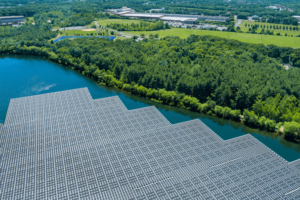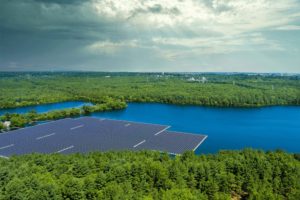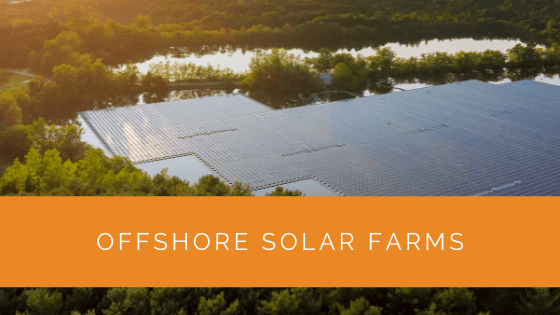Offshore solar farms have emerged as a revolutionary concept in renewable energy, offering a sustainable solution to our growing power needs. In this article, we delve into the intriguing world of offshore floating solar farms, shedding light on their innovative technology and the profound impact they could have on our energy landscape. By harnessing the sun’s power above the open seas, these projects hold the potential to address land resource scarcity and usher in a new era of clean and efficient energy generation. Join us as we explore the reasons behind the global enthusiasm for offshore solar energy and its promising future, marked by technological advancements, environmental sustainability, and worldwide applications.
Contents
- 1 Key Takeaways
- 2 Concept of Offshore Floating Solar Farms Projects
- 3 What is Offshore Solar Energy?
- 4 Why is Offshore Solar Energy a Great Project Globally?
- 5 Offshore Floating Solar System for The Belgian North Sea
- 6 Offshore Solar Project to Feature in Hybrid Marine Energy
- 7 Why is Offshore Energy a Tremendous Growing Resource?
- 8 The Benefits of Offshore Wind Energy
- 9 High-Wave Offshore Solar Panel Will Soon Be a Reality
- 10 Types of Offshore Wind Farms
- 11 Case Study: Implementation of Offshore Solar Farms in the North Sea
- 12 Expert Insights From Our Solar Panel Installers About Offshore Solar Farms
- 13 Discover the Power of Solar with Solar Panels Network
- 14 Final Word
Key Takeaways
- Offshore solar farms, known as “high wave solar,” are being tested in the Dutch North Sea and show the potential to power half of electricity consumption by 2030, addressing the scarcity of land resources.
- Floating turbines connected to mooring lines in the seabed generate electricity from moving air, offering a sustainable offshore energy solution.
- Offshore solar energy provides a clean, space-efficient, and environmentally friendly way to generate power, benefiting energy production and marine life, and has worldwide applications, particularly in coastal regions and remote islands.
Concept of Offshore Floating Solar Farms Projects
Continuous research is being conducted to find the best way to use air and solar power. Floating turbines have shown a successful way to derive electricity. The concept is based on the typical turbine.
The turbine causes the rotor to turn when moving air pushes the blade, creating electricity. The difference here is that the floating turbine is placed on a platform. It is done by mooring lines connecting to the seabed anchors.
Mooring lines like ropes or chains hold the turbine in place and send the electricity back to shore through the cable.
What is Offshore Solar Energy?
The North Sea has earmarked a large area for deploying renewable energy, to which floating solar energy has significantly contributed. Offshore solar energy is a form of deriving electricity from ocean-based resources.
The photovoltaic (PV) solar panels are established between the offshore wind turbines to utilise the available space between two air channels. Using both solar panels and wind energy to its maximum potential is possible by developments in the above method.
Why is Offshore Solar Energy a Great Project Globally?
After the installation, the world’s first offshore floating solar farm survived the winter storms and rough sea waves. It indicates all possibilities of becoming a successful form of energy services with the latest applied science.
If you go and search in the media for documentaries on such projects, you will see many points that state the benefits. You can subscribe to the menu for news that shares blogs and read some articles.
Here are a few reasons why the world needs to use this form of energy.

Land Resource Is Scarce, but The Sea Is Abundant
You must have come across many news and articles about how the world is facing scarcity in terms of resources. There may be a time when the resources will run out entirely. Marine life is an upcoming resource that provides abundant resources and space.
It is a clean way to generate energy as it doesn’t occupy space on land. You would remove spatial pressures from land by moving solar energy installation to sea.
Solar Farms Are Essential for The Future
Solar farms offer many significant advantages as they save space by utilising the same area as wind farms. When the solar panels float in the distance between the turbines, you can generate five times more energy in the same sea area.
Oceans like solar and wind offer a continuous and stable power supply. Both the seasons, winter and summer months, are favourable for it.
Creating a Sustainable Environment
The technology partners related to these global projects use the resources in a very environment-friendly way. One additional benefit of this solar partner project is that offshore solar brings opportunities for the fishing industry as the platform of the floating site acts as a protective habitat for the juvenile fish.
The platform is working on including the aquaculture industry for such large projects. The systems that are presently deployed are under constant monitoring. There is no harmful effect on the organisms that live on the seafloor as the sunlight never enters the bottom of the North Sea.
Worldwide Application
More than half of the world’s population lives in the coastal region and gets its resources, including the US. Offshore solar energy can solve the largest constraint land brings – limited area. Places like remote islands with limited land but open seas can become completely sustainable using the ocean instead of diesel generators.
Things like floating platform projects have seen new ways of heading towards a sustainable energy installation and are looking forward to its next phase.
Offshore Floating Solar System for The Belgian North Sea
The cost-competitive intracultural technology for applying the offshore floating solar panels of photovoltaic solar panels is reaching the deployment phase. It is in the Belgian coastal city to test real-sea.
They have been working on research on one of the largest information technological content for the past three years. The partners who have completed the research made good contact with getting help in designs and lab testing to reach the desired goals.
Offshore Solar Project to Feature in Hybrid Marine Energy
 There is news of developing an open offshore of oceans of energy through a co-located solar farm with floating wind turbines on the Belgian Coast. It’s part of a large-scale hybrid offshore ocean energy park demonstration.
There is news of developing an open offshore of oceans of energy through a co-located solar farm with floating wind turbines on the Belgian Coast. It’s part of a large-scale hybrid offshore ocean energy park demonstration.
The project costs around 45 million and is worked on by a group of technology and 16 expert project partners led by the Dutch Marine Energy Centre.
Why is Offshore Energy a Tremendous Growing Resource?
There are many reasons for the business of offshore floating resources to grow:
According to data, more than 18 per cent of United States natural gas and oil is produced offshore. It provides about 30 per cent of natural gas and petroleum globally.
Research says such resources are a growing source of electricity. The news is that the US has significant potential to harness this power, but a lack of commercial facilities and information in development leads to delays.
The Benefits of Offshore Wind Energy
When you look at the benefits of installing energy systems offshore, you will be amazed to know how much productive input can be extracted. Some of the advantages are:
- one of the first benefits is that offshore energy is sustainable, and it’s unlimited and non-pollutant
- there are more resources found offshore than onshore (up to two times the medium onshore wind farms)
- data shows that installation offshore has a small acoustic impact, resulting in the use of large areas freely
High-Wave Offshore Solar Panel Will Soon Be a Reality
The cost of solar panels and PV technology is constantly decreasing, making it a feasible project. The evolution towards high waves offshore applications has provided suitable conditions for making developments based on the blue economy.
The existing solar energy technology PV panels need adaptation to withstand intense wave action and current conditions while resisting saltwater. These on-site projects require highly skilled engineering and information technology. Establishing a turbine in the ocean was a challenge a few years ago, but now there has been so much development with time. Project partners are constantly aiming to develop new ideas and perform lab and field tests to take the first step towards the commercial aspect of this content.
Types of Offshore Wind Farms
There are two types of offshore wind farms:
- Marine wind turbines with fixed foundations: This structure is installed on a fixed support structure on the sea bed. Present static foundation technology will allow the installation of systems up to 60 meters below the surface.
- Offshore floating wind turbine platforms: This type of installation allows the wind generation farms to build infrastructure in deep water. The floating base makes harnessing the potential in the huge offshore areas possible.
Case Study: Implementation of Offshore Solar Farms in the North Sea
Background
At Solar Panels Network, we are dedicated to advancing renewable energy technologies. This case study explores the installation of an offshore solar farm in the North Sea, aimed at harnessing solar energy from the ocean to meet increasing energy demands while preserving land resources.
Project Overview
The project focused on establishing a floating solar farm integrated with existing offshore wind infrastructure. This dual setup aimed to maximise energy generation from both wind and solar resources, utilising the expansive sea area efficiently.
Implementation
- Site Assessment and Planning: Conducted a detailed survey of the North Sea site, analysing sea conditions, sunlight availability, and potential impacts on marine life. This assessment ensured optimal placement of the floating solar panels.
- Installation Process:
- Platform Construction: Built durable platforms capable of supporting the solar panels and withstanding the marine environment’s rigours.
- Solar Panel Deployment: Deployed high-efficiency photovoltaic panels on the floating platforms, ensuring they were securely anchored using mooring lines attached to seabed anchors.
- System Integration: Connected the solar panels to the offshore wind farm’s existing grid infrastructure, facilitating seamless energy transmission to shore.
Results
- Energy Generation: The combined wind and solar setup significantly boosted the overall energy output, providing a stable and continuous power supply.
- Environmental Impact: The project demonstrated minimal disruption to marine life, with the platforms also serving as artificial habitats for marine species. The integration of solar panels reduced the need for additional land-based solar installations, alleviating land use pressures.
- Economic Benefits: The project yielded substantial cost savings by utilising the same infrastructure for both wind and solar power generation. The investment in durable materials and advanced technology ensured long-term sustainability and reduced maintenance costs.
Summary
The successful implementation of the offshore solar farm in the North Sea highlights the potential of marine-based renewable energy solutions. This project not only provided significant economic and environmental benefits but also demonstrated the feasibility and resilience of floating solar technology. As we continue to innovate in the field of renewable energy, offshore solar farms stand out as a promising solution to meet the growing global demand for clean energy while preserving valuable land resources. The positive outcomes of this project underscore the importance of investing in advanced renewable technologies for a sustainable future.
Expert Insights From Our Solar Panel Installers About Offshore Solar Farms
Offshore solar farms represent a new frontier in renewable energy. By utilising the vast open sea space, we can overcome land constraints and significantly increase solar power production.
Senior Offshore Energy Specialist
One of the remarkable aspects of offshore solar panels is their resilience. They are designed to withstand harsh marine conditions, making them a durable and long-term solution for clean energy generation.
Chief Marine Engineer
Integrating solar panels with offshore wind farms maximises the energy output from the same area. It’s an innovative approach that not only boosts efficiency but also reduces the ecological footprint.
Renewable Energy Consultant
Discover the Power of Solar with Solar Panels Network
Are you navigating the world of solar installations? Look no further than Solar Panels Network, the UK’s trusted partner in harnessing the sun’s potential. Our dedication goes beyond just installations; we’re on a mission to transform how homeowners and businesses across the UK perceive and utilise energy. By choosing us, you’re reducing your carbon footprint and making a smart financial move that promises savings for years ahead. Contact us today and embark on your solar journey.
Final Word
Seeing the possible growth data of offshore floating solar energy, it can soon become the most feasible way of harnessing resources without damaging nature. The largest project in the North Sea has substantially impacted how the solar system farm can allow more open areas for testing future projects and share the ways to grow oceans of energy.
About the Author
Solar Panels Network stands at the forefront of solar energy solutions, driven by a team of seasoned solar engineers and energy consultants. With over decades of experience in delivering high-quality solar installations and maintenance, we are committed to promoting sustainable energy through customer-centric, tailored solutions. Our articles reflect this commitment, crafted collaboratively by experts to provide accurate, up-to-date insights into solar technology, ensuring our readers are well-informed and empowered in their solar energy decisions.

